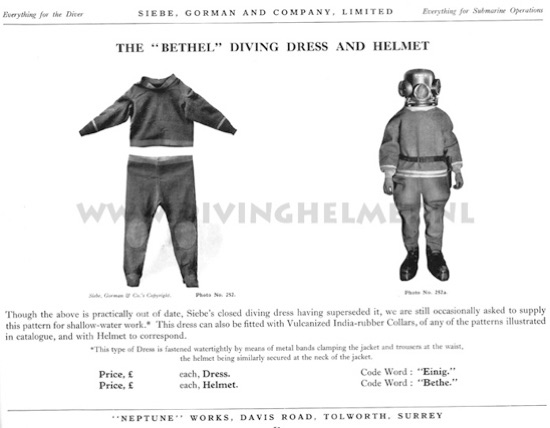The competitions’ helmets made by Siebe, Gorman & Co. Ltd.
With the discovery of the advantages of being able to work underwater, more companies started to manufacture diving apparatus of various types. Mainly in continental Europe, several interesting designs were manufactured. Around 1900 Siebe, Gorman & Co. started to produce diving apparatus of ‘continental design’ in addition to their normal 12 bolt helmet. The later sales catalogues of Siebe, Gorman & Co Ltd. illustrate all helmets shown in the 1902 edition ( as shown in the previous chapter ‘Siebe, Gorman & Co.’) But in later editions also the following continental-type helmets were on offer:
The danish ‘Hansen’s Patent’ helmet made by Siebe, Gorman & Co. Ltd.
The first time the Hansen Patent helmet is illustrated in a Siebe, Gorman & Co Ltd sales catalogue is in 1909 (Catalogue ‘D’), therefore the helmet is unlikely to have been manufactured by Siebe Gorman much before this date. The Hansen ‘Patent’ helmet was last illustrated in the Siebe, Gorman & Co. Ltd. sales catalogue, ‘D5’ of circa 1958. The helmet was manufactured by Siebe, Gorman & Co Ltd. in some quantity after a Danish rubber company decided to offer complete sets of diving apparatus instead of just the suits and hoses. Many of these helmets were supplied without a company name badge, but the helmet can be recognized by the typical Siebe, Gorman style ‘air-ducts’ inside the helmet. These ducts have typical ‘fish-tail’ shaped ends whereas original Danish style air-ducts have straight ends. Side-window grills are of the typical Siebe, Gorman style while original Danish helmets have side-window grills of the ‘Sadler’ design. (See the Sadler Chapter under ‘England’ on this website).


Above: Various images of a tinned Hansen ‘Patent’ helmet without a company badge which has an ‘enforced’ top. This helmet was probably used by ‘stone fishers’ in Denmark. The second large photograph shows another Hansen ‘Patent’ helmet of the same style, but without the ‘enforced’ top and with a company badge. ( see under ‘Denmark’ in the index of this website for more danish diving apparatus ) Photographs, David L.Dekker
Swedish style Emil Carlsson diving apparatus by Siebe, Gorman & Co Ltd.
Above: Swedish diving apparatus was invented by Axel Lindqvist during the 19th century, and was developed further by Emil Carlsson around 1910. Although the helmets have a bizarre, ‘pot-like’ look they were appreciated by Swedish divers who were still using them in the 1980s. ( see under ‘Sweden’ in the index of this website for more danish diving apparatus ) Photographs, David L.Dekker
1969. Siebe, Gorman & Co. Ltd. ‘Seacrown’ helmet
Above: the ‘Seacrown’ prototype helmet was developed during the 1960s in an attempt to keep up with the latest technological advances in diving equipment. However, only one helmet was ever built. It was shown at various trade fairs and offered in the sales catalogues, but no orders were placed and other manufacturers such as Kirby Morgan and Aquadine eventually cornered the market.
Siebe, Gorman & Co Ltd. ‘Utility’ Diving Helmet.
The helmets shown above was not introduced until sometime during the 1960s, and the design is based on the ‘Mine Recovery Suit’ (MRS) helmet of WW2. This ‘Utility helmet’ was promoted by Siebe, Gorman & Co Ltd. as an ‘economical but efficient helmet’. The black and white photograph is scanned from the Siebe, Gorman Marketing Data Sheet No. D1. The color photograph I received from a collector abroad who has 3 different styles of ‘Utility helmets’ in his collection. He kindly allowed me to show his photograph at the website, thanks.
Siebe, Gorman & Co Ltd. vs Dragerwerk, Lübeck
From 1900 to 1945 the so called ‘injector war’ was taking place between the English Siebe, Gorman company and its competitor, the German ‘Draegerwerk’ company. The ‘injector’ was a crucial part for a rebreather system which was invented by Bernhard Draeger in 1895. In 1912 the invention was declared ‘unsafe’ by a British mining board with the result that British mines were no longer permitted to use the popular Draeger rebreathers. (See chapter ‘1912 Siebe, Gorman & Co Ltd. vs. Draegerwerk’ on divinghelmet.nl).











From the mid-1950s onwards, diving equipment design was developing as new technological advances and innovation took place. This can be seen in the pioneering ‘CG45’ regulator and HP scuba tanks developed by Jacques Cousteau. Until then diving equipment had been expensive and was only affordable by the larger diving companies. However when Cousteau developed his regulators and dry-suits at much lower costs (using either scuba tanks or with surface demand), underwater work became more affordable and more widespread among a new generation of divers.
Siebe, Gorman & Co. Ltd. ceased manufacturing diving helmets around 1980. The last batches of helmets were of poor quality as many of the skilled craftsmen were made redundant when the company was restructured and moved to Cwmbran in Wales in 1975. Batches of Cwmbran produced diving helmets can be identified by having no air-ducts inside, any exhaust-valve water-lock, and 12-bolt helmets have no company name stamped on the brailles. In 1999, Siebe Gorman was sold to an Iranian businessman as a going concern, and the company was renamed ‘Air Master Technology Limited’ (AMTec) In 2000 ‘AMTec’ was relocated to Swindon in Wiltshire, but in the following year the company ceased trading. The name ‘Siebe Gorman’ was sold to a Malaysian company manufacturing breathing apparatuses and gas masks, and currently the name is used by businessmen in India who manufacture nearly perfect reproduction Siebe Gorman helmets which are sold as antiques ...
Year 2000. Siebe, Gorman & Co. Ltd. closes their diving apparatus business
1904 - 2000. Siebe, Gorman & Co. Ltd. (part 2)


‘DiveScrap’Index
the scrapbook of diving history





